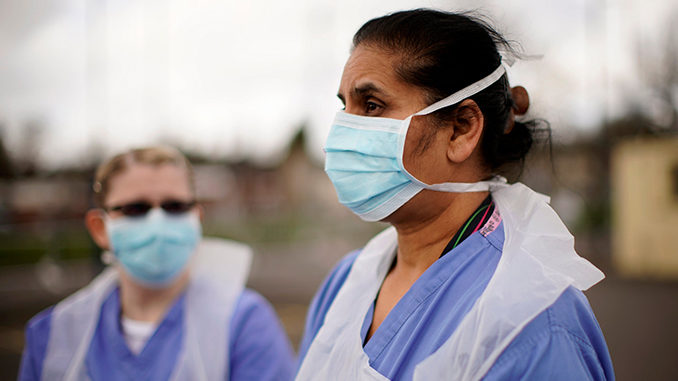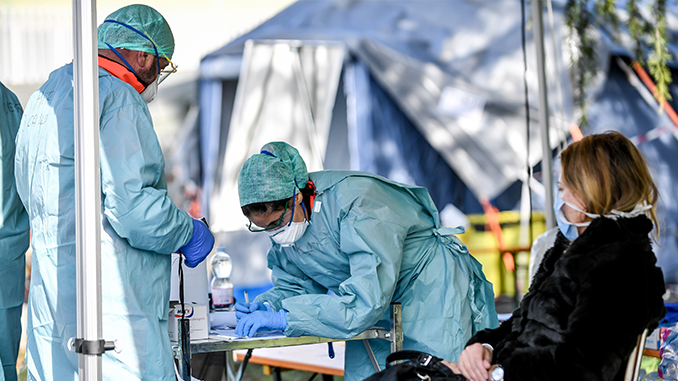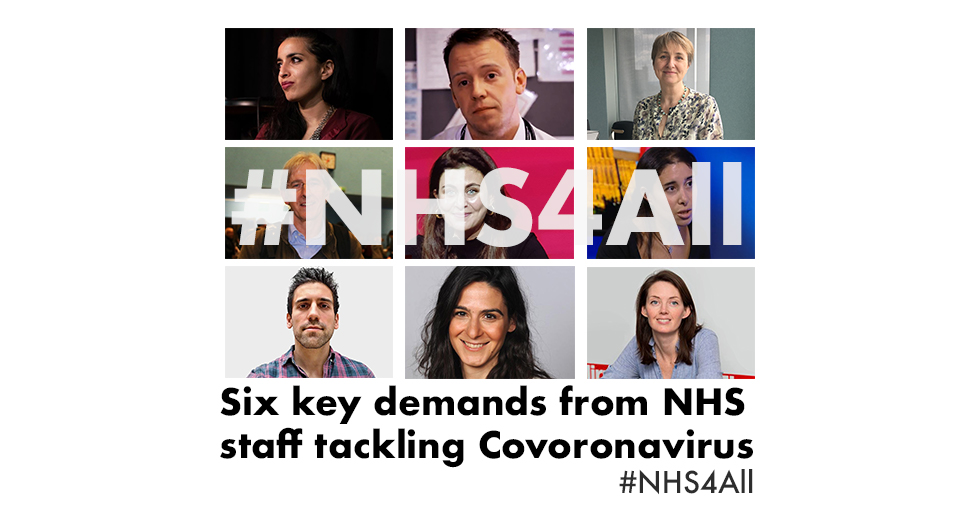
It’s clear that an urgent intervention is needed on the government’s Coronavirus response. Despite the massive threat posed by the pandemic, Boris Johnson isn't doing what’s needed to support our health workers as they confront this crisis. This is doubly alarming given that our NHS is going into action following a decade of under-funding, under-staffing, and undermining from Conservative-led governments.
That’s why a new petition putting six key demands to the government has just been launched. The demands are:
- Covid-19 testing and personal protective equipment (PPE) must be available for all NHS and social care staff now
- Those relying on social care (or ‘Direct Payments’) must be given immediate support if carers go sick
- NHS support staff (including those outsourced) must receive at least living wage, paid sick leave for illness or self-isolation and an increase in statutory sick pay
- Bring private health resources into public service without compensation to fight COVID-19 and aid NHS response
- Make all information that the Government is basing its strategy on wholly available for public scrutiny
- An immediate end to legislation enforcing eligibility checks and charging in the NHS, including those related to residency status or national origin, allowing all patients to use the NHS without fear
Please click here to sign the petition and – most importantly of all – share it now to all your friends and contacts.
The first demand relates to protecting health and social care workers from Covid-19. But there is some debate what that means in practive.
What protective clothing and equiptment do staff need?
The Department of Health and Social Care (DHSC) together with other agencies has produced guidance on how to deal with patients who are or might be infected with the coronavirus. The virus is spread mainly through respiratory droplets generated by coughing and sneezing, and through contact with contaminated surfaces. The guidance includes details of the appropriate protective clothing that should be worn in a variety of different situations. This is called Personal Protective Equipment, or ‘PPE’ and is made up of the following:
Disposable plastic aprons – these must be worn when looking after a patient or when cleaning equipment and surroundings.
Fluid-resistant gowns – these must be worn when there is a risk of extensive splashing of blood and/or other body fluids and a plastic apron would simply not be enough. Mostly this happens by doing things to a patient that might make them cough, for example putting in a breathing tube, or taking a swab for testing. These are called ‘aerosol generating procedures’.
Disposable gloves – these must be worn when looking after a patient and when contact with blood or other body fluids is likely.
Eye/face protection should be worn when there is a risk of secretions, blood, body fluids or excretions getting into the eyes. An individual risk assessment should be carried out prior to/at the time of providing care. Eye/face protection can be provided by a surgical mask with attached visor, a full face shield visor, or with safety spectacles.
There are two types of protective face masks:
FRSM stands for Fluid Resistant Surgical Mask. These are the masks routinely worn by surgeons and staff in operating theatres. They protect from virus spread in droplets, but not from the virus in the much smaller particles that make up an aerosol (see below).
FFP stands for Filtering Face Piece respirator. These protect against droplets but also aerosols.
Hospital, GPs, ambulance and social care workers are all coming into contact with patients who may or may not have coronavirus. Many are concerned that the PPE they need is not available. An additional problem is that many health workers (including GPs, and doctors on the general hospital wards) feel that they should have an FFP mask if they are going to be in contact with patients who may/do have coronavirus, despite the guidance saying a FRSM is adequate, and that fluid resistant gowns should also be available, for example when working on a ward with infected patients.
FFP are also called disposable Respiratory Protective Equipment (RPE) and protect against dusts,particles and aerosols. They are often referred to as 'disposable dust masks', and are widely used in industry; the FFP3 has the highest filtering efficiency.
These masks rely on a good seal against the face so that, when you breathe air in, it is drawn into the filter material where the air is cleaned. If there are any gaps around the edges of the mask, ‘dirty’ air/dust/droplets will pass through these gaps and into your lungs. It is therefore necessary to make sure the mask fits by doing a ‘fit test’. A simple fit test as used in the NHS involves seeing whether or not the wearer can taste a bitter- or sweet-tasting aerosol when wearing the mask. The best time to do fit testing is at the initial selection stage, when individual users can be given a choice of different models of mask to try. However, having found one that fits, you should then ensure that the same make, model, type and size of facepiece is made available for that person to continue to use. Clearly there needs to be an efficient method of providing fit testing for staff in different locations.

Should FFP be the mask of choice in all situations of proximity to patients?
The main difference between the commonly used surgical mask and the less commonly used FFP is that only the FFP will trap aerosol (providing the mask fits properly and continues to fit while being worn).
Studies by the Health and Safety Executive comparing a range of surgical masks (FRSM) with FFP for protection against influenza in airborne particles showed that in the laboratory the FFP masks were far superior while all surgical masks let live viruses through. HSE commented that: "There is a common misperception that they will provide protection against aerosols. . . . .The results of this study confirm that surgical masks provide the lowest level of respiratory protection compared to FFP respirators.” In other words, it is clear that in laboratory tests FFP were much more effective than FRSM.
‘Aerosols’ refer to particles smaller than ‘droplets’ that have the capacity to travel further in the atmosphere, including down into the lungs. It is known that coughing produces an aerosol. The DHSC recognize that doing things to patients that generate an aerosol means an FFP must be worn, and therefore demonstrate an acceptance that coronavirus is an airborne disease. Despite this, however, the DHSC guidance does not acknowledge that being coughed over in an ambulance or GP surgery poses a risk of virus transmission by aerosol.
In contrast, the US ‘Centres for Disease Control and Prevention’ regard the FFP type mask as optimal, summing it up by saying: “Facemasks protect the wearer from splashes and sprays. Respirators (i.e. FFP), which filter inspired air, offer respiratory protection.” The CDC has recently said FRSM are acceptable as an alternative but only when there is a shortage of the more expensive FFP type masks.
Conclusion
By the 4thth March 2020, 3,400 Chinese health workers were infected with coronavirus and 13 had died including the brave Dr. Li Wenliang who first brought the disease to the attention of the authorities, for which he was severely reprimanded. It is vital that all health and social care staff coming into contact with patients have the best possible protection. This must include PPE as outlined in the current guidance from the DHSC, but in addition, staff must also be given the choice of wearing FFP masks as an alternative to FRSM, and fluid resistant gowns. Solving problems of production and distribution together with provision of fit testing must be speedily resolved by NHS England with the support of government.
Keep Our NHS Public Co-Chair John Puntis








Leave a Reply